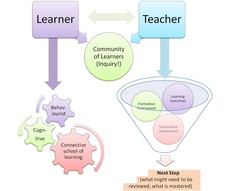This is the third or fourth time that I have seen the video by Sir Ken Robinson "Schools Kill Creativity - http://www.ted.com/talks/ken_robinson_says_schools_kill_creativity.html. I have watched this video in classes and at conferences. I really enjoy listening to Ken Robinson talk and I think I have seen all his RSAnimate talks and I take the chance of listening to him.
I really enjoyed the part when he talks about the little girl in the art class drawing a picture of God and his son’s play where the kids will take chances when they don’t know what the right thing to do or say is. I think this is a great part of working with kids, they are not afraid to take chances and make mistakes! It is like Ken says “If you are not prepared to be wrong, you’ll never come up with anything original.”
My question is: Why do you think that schools use the hierarchy that he suggests where arts are at the bottom (and in my experience get about an hour of representation a week) and does not put the same focus on all subjects, is it not feasible? I know that the ministry has a breakdown of how much time each week should be spent on each subject, but why do you think it is that way?
As a secondary question, just because I am curious, has anyone
had the student in their class that needed to move to think?
I remember having a grade 2/3 class and had 4 students that I could
relate that to. If you did, what
did you do with them – did you foster their need to move or have to suppress
it?
I really enjoyed the part when he talks about the little girl in the art class drawing a picture of God and his son’s play where the kids will take chances when they don’t know what the right thing to do or say is. I think this is a great part of working with kids, they are not afraid to take chances and make mistakes! It is like Ken says “If you are not prepared to be wrong, you’ll never come up with anything original.”
My question is: Why do you think that schools use the hierarchy that he suggests where arts are at the bottom (and in my experience get about an hour of representation a week) and does not put the same focus on all subjects, is it not feasible? I know that the ministry has a breakdown of how much time each week should be spent on each subject, but why do you think it is that way?
As a secondary question, just because I am curious, has anyone
had the student in their class that needed to move to think?
I remember having a grade 2/3 class and had 4 students that I could
relate that to. If you did, what
did you do with them – did you foster their need to move or have to suppress
it?

 RSS Feed
RSS Feed
